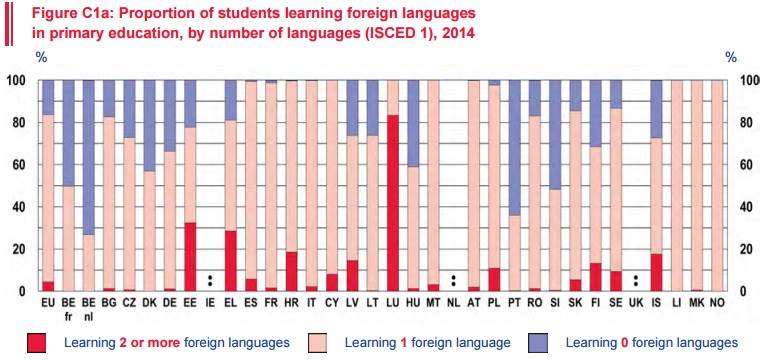Multi-linguistic pupils: what foreign languages European pupils learn in school and when do they start studying them
In most European countries, studying a foreign language is compulsory for pupils starting with the age of 6 or 7. Within the European Union (EU), French and English still remain the most studied languages, according to a recent report of the European Commission.
In 2014, the year at which the cited document refers to, in 12 European countries, pupils in primary school were studying at least a foreign language. These are Spain, France, Croatia, Italy, Cyprus, Luxembourg, Malta, Austria, Poland, Liechtenstein, Macedonia and Norway. By contrast, in Belgium, Portugal and Slovenia, more than half of pupils from primary school were not learning any foreign language.

Two years later, in 2016, in most European countries, the proportion of time dedicated to studying foreign languages within the total time dedicated to primary education was still modest, between 5% and 10%. Nevertheless, there are significant differences in Luxembourg, where the percentage is of 44% for example. Regarding the children in pre-school within the EU, nearly 60% of them were learning at least two foreign languages. Compared to 2005, this is an increase of 13%.
According to the report, in Estonia, Greece, Italy, Luxembourg, Malta, Poland, Romania, Finland, Iceland, Liechtenstein and Macedonia, more than 90% of children in pre-school were studying at least two foreign languages. In the case of pupils at vocational high schools, 34,5% of them were studying at least two foreign languages.
Overall, at least 90% of pupils in the general compulsory school were studying two or more foreign languages, while for the pupils in the vocational schools, the percentage is equally high only for Romania.
In all European countries, English is the most studied language, both in primary and secondary school. It is also a compulsory subject in almost all European educational systems where studying a foreign language is obligatory.

The proportion of pupils learning English increased in the past decade, especially regarding primary school.
According to the EF English Proficiency English Index report, made by EF Education First in 2016, the top 7 countries where English is best spoken are The Netherlands, Denmark, Sweden, Norway, Finland, Singapore, Luxembourg, countries in the ”very high proficiency” category.
The following 13 positions represent the ”high proficiency” category, and include Austria, Germany, Poland, Belgium, Malaysia, Philippines, Switzerland, Portugal, Czech Republic, Serbia, Hungary and Romania. This category means that the people can give presentations in English at their workplace, understand TV programme in English without needing subtitles, therefore are able to read and understand texts in English.
The 13 countries in the ”moderate proficiency” category include Slovakia, Bulgaria, Spain, Italy, France, South Korea, Vietnam and Indonesia.
Besides these, there are also the ”low proficiency” and ”very low proficiency” categories, where the bottom countries are Laos, Libya and Iraq.
In the EU countries where pupils study a second foreign language, French and German are the most common options.
French is the second most studied foreign language in European countries. Nearly 34% of European pupils in lower secondary school (from fifth to eighth grades) and 23% of pupils in high school were studying it in 2014.
German is the third most studied foreign language in Europe, with 23,1% of children in grade 5 to 8 studying it, as well as 23% of those in high school. On the other hand, in some countries, especially those with several official languages, such as Belgium, Luxembourg or Switzerland, French and German are even compulsory.
By comparison, Spanish is not obligatory to be studied as a foreign language in no European country, with Malta imposing Spanish as an optional subject.
Several languages that are less spoken are studied as foreign languages in some countries, due to historic reasons or their geographic position.
For example, in Finland, Swedish is the second most studied foreign language, being studied by 92,3% of pupils in lower secondary school. The proportion is of almost 88% in high school.
In Iceland, Danish is the second compulsory foreign language, being studied by 96,6% of pupils in lower secondary school.
In Malta, nearly 60% of pupils in grades 5th to 8th learn Italian, even though it is not compulsory. Within the EU, only 3% of high school pupils study Italian.
On the other hand, over 10% of pupils in Croatia, Cyprus, Malta, Austria and Slovenia are learning Italian either between the 5th and 8th grades or in high school.
Russian isn’t more popular either, with only 2,8% of European high school pupils studying it. Russian is being studied by 10% of pupils of at least one educational levels in Bulgaria, Czech Republic, Estonia, Cyprus, Latvia, Lithuania and Slovakia.
In the Baltic countries, 60-70% of pupils in the lower secondary school study Russian.